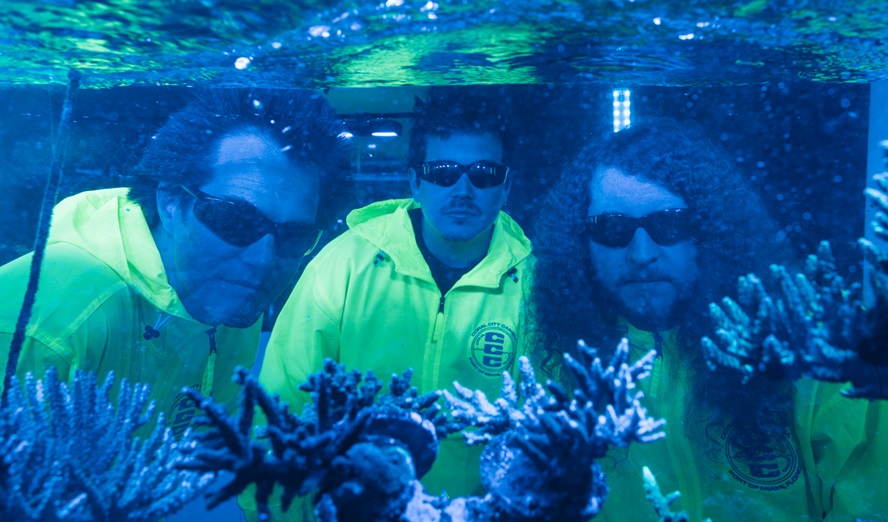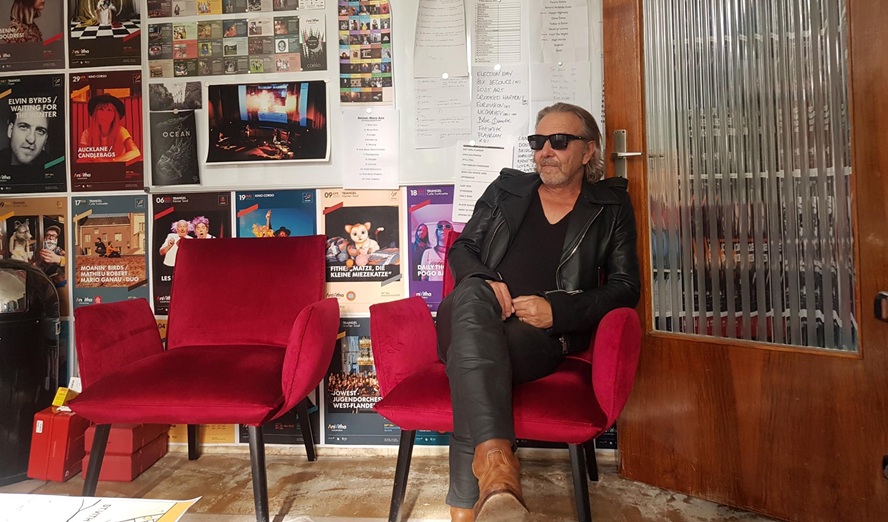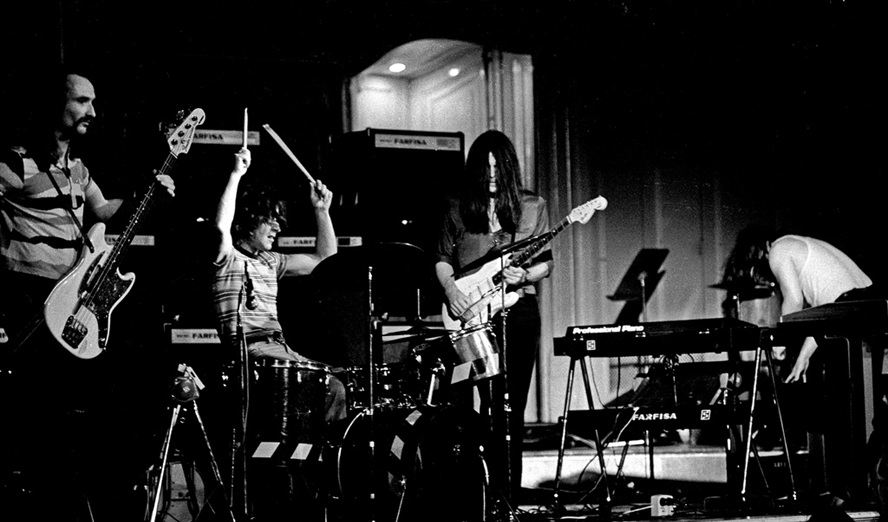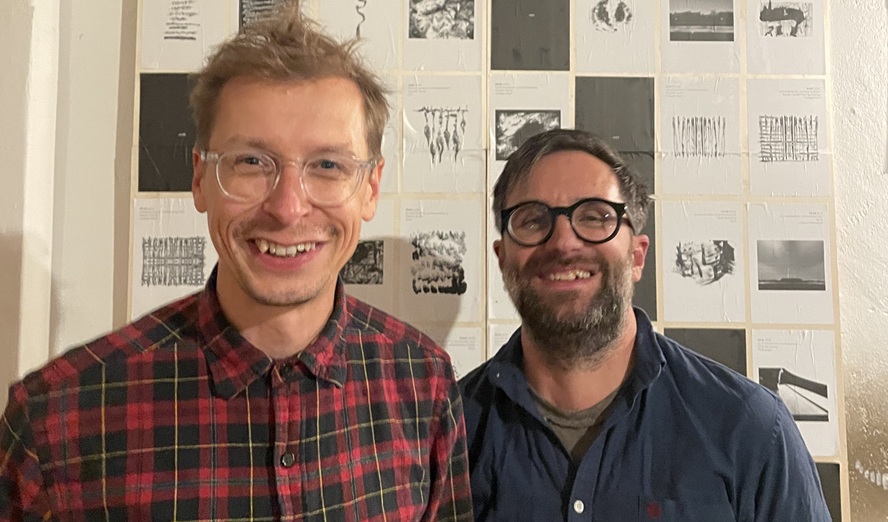Mit Wasser, insbesondere dem Meer, verbindet wohl jedes Baby die Ideen des Fließens und der ewigen Wiederkehr, der Geborgenheit des Mutterleibs, des Aufgehens im Ganzen – aber auch der Gefahren, die darin lauern. Man denke da nur an den weißen Hai, Godzilla, Moby Dick, irgendwelche bizarren Krustentiere oder auch U-Boote, die nicht auf dem Radar aufscheinen, aber irgendwann überraschend auftauchen und dann BOOM. Wasser ist Leben, klar, aber Meer ist auch mehr als das. Oftmals sieht man unter Wasser kaum 2 Meter weit und alles dahinter: unbekannt und potenziell gefährlich. Das Meer kann aber auch sehr schön sein, farblich, von den Formen her. Und besänftigend, von der unregelmäßigen Regelmäßigkeit des Rauschens und Gluckerns. Oder rührend, wie die Sounds der Buckelwale, Klassiker im Bereich der Field Recordings (obwohl Tiermusik bei diesen Songs doch weitaus akkurater wäre). Die Faszination für das Leben unter Wasser hat auch Gruppen wie Yo La Tengo angetrieben, einen Soundtrack für die Aufnahmen von Jean Painlevé zu spielen. Passend zur verspielten und melancholischen Art der Band. Coral Morphologic nun besteht seit 2007. Der Meeresbiologe Colin Foord und J.D. McKay, Musiker, haben sich damals zusammengetan, um am Schnittpunkt Musik und Natur/Korallen zusammenzuarbeiten und eine Plattform zu erstellen, auf der das Wissen über die Welt der Rhizome spielerisch für die Zukunft weitergegeben wird. Denn offensichtlich ist: Diese Viecher haben es nicht leicht.
Das Album »Projections of a Coral City« ist das bereits dritte der beiden, das erste gemeinsam mit Nick León, der sich üblicherweise im Bereich Latin Electronic bewegt und zudem als Produzent für Denzel Curry und Rosalía in Erscheinung trat. Das Album verbindet verschiedene Bereiche von Ambient und Progressive Electronic und entwickelt einen wässrigen, zwischen pastelligen Blautönen mäandernden Sound. »Deep Call« raunt durch einen sub-aquatisch installierten Lautsprecher einnehmende hallige, hohe Tonfolgen mit dem welligen Auf und Ab der Küste. Harold Budd: erkennbar. In »Hearts Aflutter« sind die Bewegungen der Flora und Fauna in Küstennähe in all ihrer Pracht noisig-kuschelig wahrnehmbar – und es geht tiefer und tiefer hinab, in ruhige Gefilde. »Discovery« klingt noch stärker nach Budd, was einfach durchwegs schön ist: Töne, die wie unendlich ineinander verschwimmen und verquirlen. »Prespice« kommt düsterer daher. Wer Dr. Roger Paynes Aufnahmen der Buckelwale, damals bei Zweitausendeins erschienen, kennt, der weiß, was es heißt, in diesem Fall von einer Unterwasserunheimlichkeit zu sprechen, die in ihrer Tiefe und Erhabenheit schon mal die Nackenhaare aufstehen lässt. »Reach Out« mit seiner repetitiven Art lässt an William Basinskis »Water Music« denken, gesprenkelt eben mit Aufnahmen aus Unterwasser, diesem typischen hohlen Klopfen, das klingt, als käme es von allen Seiten und aus einem selbst und als wäre man Teil von diesem Allen. Doch »Projections« will zugleich noch etwas mehr sein … Wir haben mit einem der drei, Colin Foord, gesprochen.
skug: Where does your enthusiasm for corals come from and what do they have to do with us humans?
Colin Foord: When I laid eyes on a brain coral snorkeling for the first time at the age of 5 in Mexico, I was hooked; here was a living animal that looked like a brain, was dependent on the sun, and created »rock«. »What the heck is going on here?!?« was my reaction, and I decided I would spend the rest of my life trying to figure it out. Besides humans, corals are the only other organisms that create colonies visible from space. They are the first city builders, astronomers, and timekeepers of our planet. They are ancient techno-futurists that we, as a so-called intelligent species, are only just now beginning to understand. We must learn from the corals in order to become symbiotic stewards of our planet. Humans are not above nature, and we are all in the same fishbowl together.
What fascinates you all about the sea and water in general?
It is a whole different world underwater. The movements are fluid, the sounds are totally different than in air. It sounds cliche, but when I am in the water (and not too cold), I am in my happy place. Water is the magic of planet Earth, really the magic of the universe. Liquid is a rare state of matter, and water only exists as a liquid in a small window of temperature. Without water there is no life. The way ice forms is amazing; the angles of the water molecules arrange themselves into hexagons (the same hexagonal symmetry we find in stony corals), and because of this solid ice floats on liquid water, which is extremely rare for matter to do. Imagine, if ice sank, life would have had a much harder chance of evolving as our planet would have turned into a solid ice cube rather than an ocean with a blanket of ice on the surface. Whatever you might believe theologically or scientifically about the origin of life, we should all be able to agree that the conditions we have here on Earth are about as magical and rare as winning the lottery. If we were created, I would imagine our creator would judge us on how well we keep their planet clean and healthy. And if it’s all just statistical dumb luck, then we should use our so-called intelligence to keep the planet clean and healthy. Regardless (or »irregardless«, as we say in Miami), the ocean, 71 percent of Earth’s surface, is worthy of a rhapsody.
Why is the connection between art and science so important?
Science deals with the objective, while art deals with the subjective, and where they overlap you can find literal metaphors. Through metaphor we are able to convey complex ideas with understandable concepts. The concept of Miami as the Coral City is both literal and metaphorical. Superficially, corals are neon, tessellating, living artforms. That alone is enough to warrant human attention, but beneath the fluorescence we extrapolate the deeper meanings, the metaphors. It is difficult to build empathy between humans and organisms lacking a cute face or even a brain. We hope to create new connections between corals and humans by demonstrating that we are not so dissimilar to each other despite our radical differences in form.
What is the special connection between corals and music?
The underwater world is about as alien an environment as we get here on Earth. When you are underwater, time and space feel different. All life originated in the oceans, and the womb is the ocean we emerge from. Our brains are hardwired initially by interpreting the sounds we hear through the liquid medium of our mother’s body. There is something inherently relaxing about water and the ocean, and we even have a mammalian aquatic reflex that kicks in in cool water. Clinical trials have shown that watching fish swim in aquaria reduces blood pressure and anxiety. In an increasingly anxious world we are living in, we believe that a combination of watching coral reef life with the right music can be a natural form of therapy. Accessing coral reefs IRL is expensive, time-consuming, and carbon-intensive. Through our Coral City Camera project, we believe we can bring the coral reef into everyone’s living rooms, classrooms, and doctor’s offices. Music is a synergistic element to nurturing this biophilia. Our hope is that new technology like satellite internet will open up huge swathes of the planet to broadband data, making the world a smaller place by connecting people with people, and people with the environment.
How did the collaboration between you and J.D. come about in the first place? What about the cooperation with Nick Léon?
J and I have been friends since we were teenagers. In highschool we played in punk rock bands together, and after I set J up with a saltwater aquarium in 2004, our creative collaboration led to the formation of Coral Morphologic. In 2017 we were turned on to Nick’s music, and his approach to ambient inspired J to record his albums »Coral Morphologic 1 & 2«. A slow progression of small collaborations naturally led us to »Projections of a Coral City«.
What music inspired you while writing the »Projections«?
We all enjoy the ambient and film music of Harold Budd, Brian and Roger Eno, and more recent composers like Mica Levi, Ludwig Göransson, and Jóhann Jóhannsson.
The sea is usually expressed in music as calming, the melodies as warm. Don’t you think that it also has incredible potential for gloom and horror?
Yes, no doubt. We often refer to Werner Herzog’s quote about the Amazon rainforest in the documentary »Burden of Dreams« as an analogue to the beautiful chaos of the coral reef: »Nature here is violent. I would see fornication, and asphyxiation, and choking. And fighting for survival, and growing, and just rotting away.«
Even without the dying reefs, plastic pollution and global warming, there is something sad and melancholy about the sea. I’m thinking not least of the song of the humpback whales and the endless expanse of the oceans… right?
I think it depends where in the world you are on the ocean. Cold dark water can definitely create a brooding atmosphere, but here in Miami, not so much. It was the crystal blue waters of the Bahamas that captivated the Western world 100 years ago when the first underwater films and scenes from coral reefs became cultural phenomena. Waters north of the subtropics, cold and dark, were a virtual death sentence to anyone that fell in them. But the clarity of the tropical water made it less foreboding by being able to see predators like sharks at a safer distance. Author Ann Elias in her book »Coral Empire« argues that architects in the early 20th century were inspired to design skyscrapers out of glass for our cityscapes born of our fascination with clear water and its optical clarity for sunshine. Corals as city builders; as above, so below. For »Projections of a Coral City« there is an undercurrent of darkness. One because the site-specific installation was for nighttime viewing, two because life on the reef can end instantly at night where the fishes must sleep with one eye open. And thirdly, because it forecasts a future where Miami becomes a new Atlantis and marine life re-colonize our human structures as artificial reef. The concrete in these buildings was made from limestone created by marine life and corals thousands of years ago. There is a poetic ouroboros at play; Miami is where the snake eats its tail.
What is the state of the world’s reefs at the moment? Is there still hope?
The world’s reefs are being forced to cope with rising sea surface temperatures the likes of which the planet hasn’t seen in hundreds of thousands of years. Even the most remote reefs, far from human civilization, are bleaching. We like to say that the motto of the coral is »adapt or die«, because when you are cemented in place, you can’t just swim off to a better place. Corals have been alive on Earth for around half a billion years and survived multiple extinction events. They have come up with a variety of ways to maximize their survival; asexual cloning, hermaphroditism, synchronized group sex to mix their genes across the community, symbiosis with algae, fluorescent sunscreen, microbial mitigated immunity, and on and on. We have something to learn from them when it comes to survival and adaptation. The world we are born in is nothing like the one we die in. Humans must also adapt, and at ever-increasing rates, as climate, social, economic, and technological conditions change. Creative people are having to adapt especially quickly, as things like AI can both make their jobs easier and harder to make a living. Technology is a blessing and a curse. The same fossil fuels that power our development, create the problems that challenge our success. In the end we are all dogs in the same hot car. Humans have been building cities for only around 5000 years now, which is about the average age for a single coral reef. If we can decenter ourselves and look to corals and other species for advice on how to live, maybe we can find our place as contributors to the community that is nature.



















